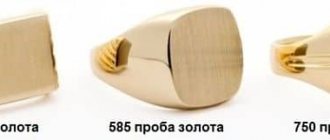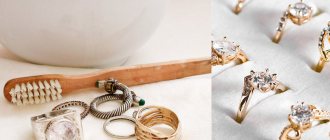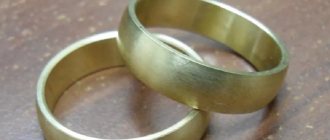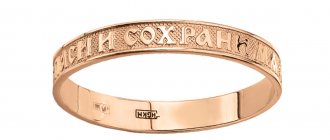Gold is one of the most popular metals. It has always been in fashion; gold jewelry is still purchased by many people to this day.
Also, gold has always been a profitable solution for deposits and storing money, especially during periods of crises and economic instability. But because of this popularity, scammers have long appeared who counterfeit gold jewelry. No one likes to be deceived when buying expensive products. And therefore you need to understand and know how the gold standard is determined at home.
What is a gold sample and how to check it? Many people know that among gold products there are practically no items consisting entirely of this metal. And in most cases, they additionally contain other elements, such as silver, copper or nickel. They are added to increase the strength of the alloy, because gold is a very soft metal. Sometimes this is done simply to diversify the color component - as a result, jewelry can become pink, reddish or even greenish.
A three-digit number is stamped on the gold—the hallmark itself. It indicates the ratio of the amount of precious metal in the jewelry. The hallmarks are different, for Russia, for example, the following are established: 375, 500, 585, 750, 950, 999. And these numbers mean how many parts of the metal in the jewelry out of a thousand are gold. For example, 750 standard - per thousand pieces of jewelry 750 is made of precious metal, that is, 75% of the jewelry is gold.
Unlike Russia and the CIS countries, in the rest of the world the quality of gold products is determined using karats. The maximum number of carats for the alloy is 24, which means that the jewelry is entirely gold. To convert foreign carats into the standard we are used to (for example, when buying jewelry abroad), you need to do the following: divide the number of carats by 24, and multiply the result by a thousand. For example: 18-karat gold: 18÷24*100 = 750. Result: 18-karat is equal to the 750th standard. By calculations you can get the following comparison table:
| Carats | Try | Gold percentage |
| 24 | 999 | 100% |
| 18 | 750 | 75% |
| 14 | 585 | 58,5% |
| 12 | 500 | 50% |
| 9 | 375 | 37,5% |
| 8 | 333 | 33,3% |
It is possible that the sample is missing. It may be missing if the product has been altered or restored.
Checking precious metal for authenticity
Before finding out what standard is on the jewelry, it is advisable to find out whether the product is made of gold at all. If it turns out to be just gold-plated, then there is no point in wasting time and determining the sample of the missing valuable metal.
The easiest way to identify gold is by using its magnetic properties. This metal practically does not react when a magnet approaches it. It is logical to assume: if the jewelry being tested is attracted to a magnet, then it is nothing more than a fake with gold. Although in the rarest cases the product may consist of gold, but of the smallest standard. However, it makes no sense to pay for it like gold.
However, there are other metals that are not magnetic, such as copper or aluminum, which is a disadvantage for testing with a magnet.
There is another simple way to identify gold. For this you will need ordinary vinegar. If the product is placed in a vinegar solution for some time, and no specific reactions occur and no changes in color occur, then the gold is genuine. If the check was carried out on a gold-plated fake, it would, at a minimum, darken.
A similar method can be used using iodine. The surface of the product will have to be scratched a little with fine-grained sandpaper. Next, apply iodine to this area using a cotton swab. If the treated part darkens, you have gold, since other metals will not react to iodine in any way. But this method has a clear drawback - the iodine stain is very ugly, and it is unlikely to be easy to remove.
There are people who can identify gold by ear. But few are capable of this, since it is actually very difficult. Individuals with an ear for music succeed in this, and, accordingly, in complete silence. How to recognize this precious metal in this way? You just need to drop it from a small height onto a flat and hard surface. Gold is a ringing metal, and when it falls it will make a beautiful ringing sound, like crystal vibration. If other metals predominate in the product, then the sound will be muffled, it will even hurt the ear.
Another simple way to detect gold at home is to test with bread. To do this, the product must be placed in the pulp of bread, only fresh bread. Bread should be stored in a cool and dark place. After a few days, take out and break the already stale loaf. If green traces of oxidation appear on the product, it means that it is not made of expensive metal or with large admixtures of other elements.
Spool (Russian) system
Used in the Russian Empire and the USSR. It was abolished in 1927 and is now practically not used.
In the old days, one of the units for measuring mass was the pound, equal to approximately 450 grams. One pound consisted of 96 spools, which was taken as the basis for the spool system.
Thus, the spool test corresponds to the number of precious metal spools in 1 pound of alloy. Typically, jewelry had a sample size of at least 36 spools. In terms of the modern system, this is the 375th sample.
The spool (Russian) sample is converted to metric using the formula: number of spools x 125: 12.
Determining the fineness of a gold product
Once it has been determined that the product is genuine, you can begin to determine its sample. You can find out using the following methods:
- chemical reagent - drop method;
- using an electronic detector;
- assay needle and touchstone.
Drip method
To determine the gold sample, you will need one of the chemical reagents. The method is quite complicated to carry out at home due to the possible lack of necessary substances or experience in performing the process. But it is carried out simply and quickly, and is quite reliable.
First, you will have to clean part of the surface of the product with a file. After this, apply a drop of the reagent to the cleaned area. After 10-20 seconds, the reagent must be removed from the surface and the changed color of gold must be assessed.
For gold less than 600 purity, gold chloride is used. For other cases, other acid reagents are suitable. The color of the stain that appears on the metal depends on the sample (for example, at 585 it is light brown, and at 375 it is green). We also pay attention to the brightness of the color: darker color means less sample. To accurately determine the shade and, accordingly, the sample, experience is needed, so this method is used mainly only by specialists.
Determination using an electronic detector
You can also determine the gold sample at home using an electronic detector. The principle of its operation is based on the electrical and chemical reactions of metals. You can find out the sample of gold very accurately, and it does it incredibly quickly - within five seconds.
Using the device, you can easily distinguish a gold-plated fake from a genuine product and even calculate the exact amount of gold in it!
The range for the detector is six to eighteen carats - range 333-750 for samples. The results obtained are shown in carats.
Despite all its capabilities, the price of such a device is not prohibitively high. Electronic detectors are available in any jewelry workshops, shops and pawn shops. But most people still believe that such a device is not suitable for home use, and purchasing it is not a cost-effective solution.
Carat system
This sampling system is widely used in the USA, Switzerland and many European countries. It shows the number of parts of pure gold, conventionally dividing the alloy into 24 equal parts.
The following carat standards are used for gold: 9, 10, 14, 18, 24. Sometimes 21, 22 and 23 carats are additionally used.
The carat standard is easily converted to metric according to the following formula: number of carats x 125: 3. It can be obtained from the equality of two ratios: carat standard to 24 and metric standard to 1000.
24 karat gold is considered completely pure. This is 999th grade and higher. If the piece is 14 karat, it is our 585 grade gold, sold in most jewelry stores. The 18 carat hallmark corresponds to the 750th metric hallmark, according to the given formula.
Tips for buying gold
You can find out whether your gold is real and what level of its quality is in two cases - before purchasing or during a home inspection. If you are going to buy a specific product, you must find out its composition, weight, and year of manufacture. Modern products are easier to classify, they bear all the necessary markings, and their composition complies with modern standards. Old gold may be marked with antique markings, and the markings may also be specially erased. To know how to determine the authenticity of gold, you need to familiarize yourself with the main features of a real precious metal.
Gold concentration
You can find out not only how real the gold is, but also what the gold content is compared to impurities. To do this, you will need the exact weight of the product, which can be found using a pharmacy scale. Knowing the weight in grams, find the bottle and fill it with water. It is better if it is a container divided into milliliters, which is sold in a pharmacy or included with household chemicals. Measure the height of the water level, which can be arbitrary, and immerse the product in the container.
Measure the distance from the original to the current water level. Next, calculations are required. Look at the marking in carats; if there is only a sample designation, convert it to carats. Take the gold weight figure for your product as the initial data. If it is 24 carat gold, the weight should be 19.3 g/mol, 12 carat - approximately 17.7, 18 carat - from 14.7 to 16.9. The initial weight of your product must be divided by the change in water level (for example, by 2-3 millimeters). The result obtained must coincide with the requirements for the gold standard; if everything matches, you are the owner of real gold.
There are more scientific, rather laboratory, ways to determine the quality and authenticity of precious metals. Using them at home is not only difficult, but also dangerous. Knowing how to spot a fake, you will never make a mistake with a purchase again and can easily identify real gold. The listed household methods are time-tested and effective.
Visual methods
Often, fakes can be recognized by carefully examining the product. The inspection is carried out from all sides, not only from the front. Joints and soldered elements are hidden in places that are invisible at first glance.
A magnifying glass will be a good aid in inspection. If you don’t have a magnifying glass with you, you can take a photo of the hallmark with a camera on your smartphone and examine it in detail under magnification.
Numbers, letters, and outer borders of the mark must be clear and even. Counterfeits are often branded using artisanal methods. The elements will be positioned crookedly, at different distances from each other.
The surface of the gold jewelry should have a uniform color. Scuff marks indicate that spraying has been applied. The coating can be of different thicknesses. If it is thick enough, the outer gold shell will not fray. In this case, solder lines of different colors will be visible. On gold jewelry they should only be at the joints of the parts.
Pay attention to discolored areas. Shades of yellow of varying intensity indicate poor quality of the alloy. If during smelting the precious metal was poorly mixed with the alloy, even an experienced jeweler cannot determine the sample size and value of such a product.
White gold is popular now. This color is given to the alloy by adding palladium and silver to the alloy. A product with gold hallmark will still have a visible yellowish tint, a warm yellowish tint. Other white metals do not have such a yellowish tint.
Smell the product
The gold product should not have any odors. This is one of the few metals that “do not smell.” Only platinum and palladium have this property. But they are more expensive than gold. It is not at all profitable for scammers to pass off platinum jewelry as gold. Even silver has a smell.
Jewelry is not just something to be smelled. It should be clenched in your fist and held for a couple of seconds. Then open your palm and smell.
A pronounced metallic smell indicates a fake.
This is how the thermal conductivity of the metal is assessed. Gold will not cool the skin.
Take a closer look at the joints
The joints of the decoration parts are soldered with gold of a higher standard. They have a lighter (sometimes greenish) tint. Solder lines are visible at the junctions of chain link elements.
There should be no lines of light yellow or green on the surface of the decoration. This may mean that a weighting agent is soldered inside.
Look at the gold in the sun and in the shade
Precious metal does not lose its shine in low light. This distinguishes gold from other yellow metals and alloys. Look at the decoration in different lighting conditions.
The intensity of the shine should be maintained. If the item is gold plated, it will fade under bright light. A thin layer of gold plating loses its ability to reflect light.











